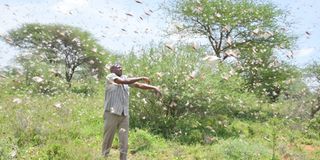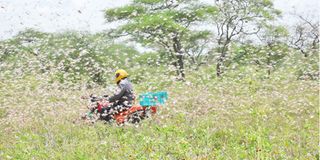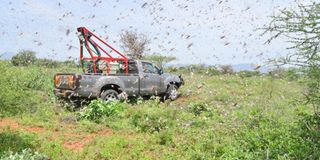Premium
Residents count losses after locusts invade Kajiado

A resident of Oloomanyat, Ilmukutani Location in Kajiado County attempts to fight a swarm of locusts after they invaded the area on February 18, 2021.
Kajiado residents are counting losses after swarms of desert locusts invaded part of the county, destroying pasture and crops.
The locusts have been sighted in Ilmukutani, Selengei, Masimba and Lekisim and there are fears that they will spread to other areas.
The residents said a good chunk of pasture in the semi-arid area, which relies heavily on livestock rearing, has been destroyed.
“We woke up to find our crops and grass eaten by the desert locusts. We fear for our livestock and sources of livelihood,” said Mercy Lemayian.

A resident of Kajiado County use a boda boda to scare away a swarm of desert locusts that has invaded the area on February 18, 2021.
Ilmukutani Location chief James Lesinko said the swarms invaded the area on Thursday evening from the neighbouring Makueni County.
He said he notified county and national governments and that teams were sent to fight the pests.
Last week, the Igad Climate Prediction and Applications Centre (Icpac) warned that at least 23 counties in Kenya, including Kajiado, are at very high risk of a fresh invasion by desert locusts.
The others are Garissa, Mandera, Isiolo, Tana River, Lamu, Kilifi, Taita Taveta, Kwale, Machakos, Kitui, Embu, Meru, Tharaka Nithi, Samburu, Kirinyaga, Narok, Migori, West Pokot, Bungoma, Kakamega, Trans Nzoia and Turkana.
Kajiado County’s Agriculture and Livestock minister, Jackline Koin, said the county is at risk of a famine should the swarms increase in number.
“The swarm first invaded Masimba. After spraying, some left Selengei and Lekisim. We are monitoring them to guide decimation efforts. The locusts eat grass, pasture and crops and can cause locals to go without food,” said Ms Koin.

A vehicle used by Kajiado County to spray chemicals in areas invaded by desert locusts is pictured at Oloomanyat Village in Mashuru on February 18, 2021.
She said the county government has set aside Sh5 million from its emergency fund to fight the pests and asked residents to report sightings to agricultural officers or chiefs.
“The residents should not graze their livestock in areas where spraying has taken place, for two weeks, to allow the potency of the chemicals to decline as they are not safe for livestock and humans,” she said.
Ms Koin added that Kajiado is working closely with the State department for Agriculture, particularly the crop protection unit, and the Food and Agriculture Organization (FAO) in efforts to rid the county of the locusts.
“Should we get overwhelmed, they will help with aerial spray using helicopters,” she said.





